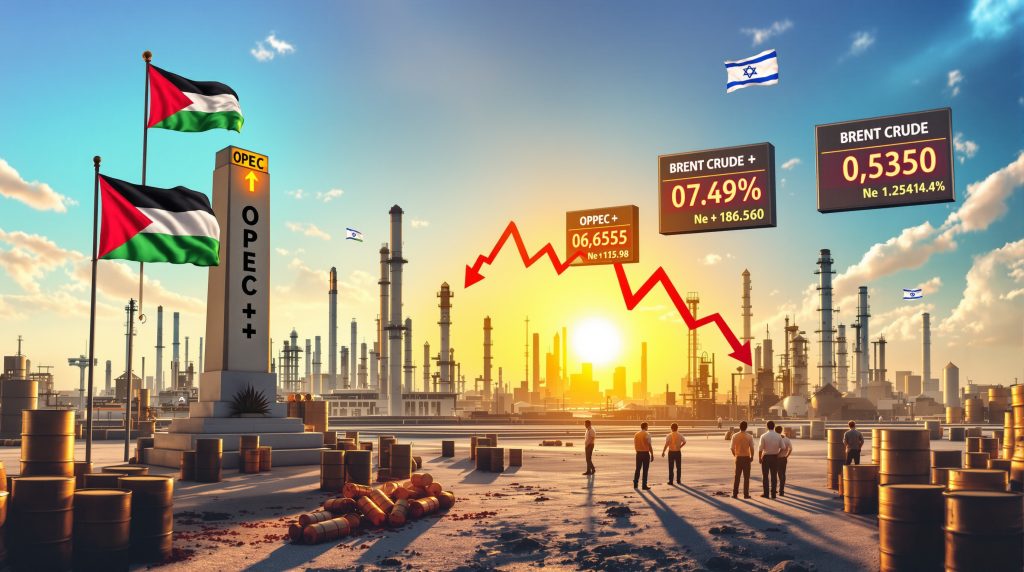The Geopolitical Risk Premium in Oil Markets
When tensions flare in the Middle East's oil-rich regions, global markets typically incorporate a "risk premium" into crude oil prices. This premium represents traders' financial buffer against potential supply disruptions that could result from regional conflicts. The mechanism has long been a fundamental component of oil price movements during geopolitical crises.
Risk premiums fluctuate based on the perceived severity and proximity of conflicts to major production areas. During high-tension periods, these premiums can add $5-15 per barrel to crude prices, significantly impacting global energy costs and economic stability.
Understanding Risk Premiums in Oil Trading
Risk premiums function as financial safety margins against uncertainty in global oil markets. When geopolitical tensions escalate, especially in regions responsible for significant oil production or transportation, these premiums increase to reflect the elevated probability of supply disruptions.
Market analysts track these premiums closely as they reveal trader sentiment about potential supply chain vulnerabilities. During periods of relative stability, these premiums diminish, allowing oil prices to better reflect fundamental supply-demand dynamics rather than fear-driven speculation.
The premium calculation involves complex risk modeling that considers factors like conflict proximity to oil infrastructure, historical supply disruption patterns, and the availability of alternative supply routes.
Historical Precedents of Conflict-Related Price Movements
Previous Middle East conflicts have established clear patterns in oil market behavior that help predict future responses to regional tensions.
| Conflict Period | Price Impact | Recovery Timeline |
|---|---|---|
| 1990 Gulf War | +65% spike | 3-4 months |
| 2003 Iraq War | +15% rise | 2-3 months |
| 2019 Saudi Aramco attacks | +20% jump | 2 weeks |
| 2022 Russia-Ukraine | +30% surge | 6+ months |
These historical cases demonstrate how rapidly markets can react to geopolitical developments and the varying recovery timelines based on conflict resolution speeds. The oil market's institutional memory of these events shapes its response to new conflicts, with traders applying lessons from previous crises to current situations.
The Gaza Ceasefire Effect on Current Oil Markets
The implementation of the Gaza ceasefire in October 2025 triggered immediate and substantial movements in global oil markets. West Texas Intermediate (WTI) crude fell below $60 per barrel while Brent prices dropped below $64 per barrel, representing significant declines from their pre-ceasefire levels.
This price adjustment reflects the market's rapid reassessment of regional supply risks as tensions eased between Israel and Hamas. The removal of fear-based pricing has allowed fundamental market factors to reassert their influence on global oil valuations.
Immediate Market Response to Ceasefire Announcement
Oil futures markets responded decisively to the ceasefire announcement, with major benchmarks showing clear downward movements:
- WTI crude: 4.15% decrease to $58.96 per barrel
- Brent crude: 3.76% decrease to $62.77 per barrel
- Murban crude: 3.83% decrease to $64.25 per barrel
These declines occurred within days of the ceasefire announcement, demonstrating how rapidly the market adjusts risk premiums when geopolitical landscapes shift. Trading volumes during this period were notably higher than average, indicating widespread participation in the repricing process.
Price Stabilization Patterns Following Peace Agreements
Following the ceasefire implementation, market volatility decreased substantially as traders gained confidence in the durability of the peace agreement. Trading ranges narrowed considerably, with daily price swings moderating from 2-3% to less than 1% on most days.
This reduction in price volatility signals the market's transition from crisis-mode trading to more routine assessment of fundamental factors like inventory levels, seasonal demand patterns, and production adjustments from major oil-producing nations.
Historically, such stabilization periods last 2-4 weeks as the market fully digests the implications of conflict resolution and reestablishes normal trading patterns.
Why Do Oil Prices Fall When Ceasefires Are Implemented?
The relationship between conflict resolution and oil price movements involves several interconnected market mechanisms that respond to changing risk perceptions among traders, investors, and physical oil buyers.
Risk Premium Reduction Mechanics
When ceasefires take effect, traders rapidly recalculate the probability of supply disruptions, triggering multiple market adjustments:
- Unwinding of speculative long positions accumulated during the conflict period
- Reduction in hedging activity by physical oil buyers as protection becomes less necessary
- Decreased options premium for supply disruption protection instruments
- Reallocation of investment capital away from "safe haven" energy assets toward other opportunities
These mechanisms operate in concert, creating downward pressure on prices that can persist for several trading sessions as different market participants adjust their positions at varying speeds.
The unwinding process isn't instantaneous—institutional investors typically reduce positions more gradually than speculative traders, creating a cascading effect that can extend price adjustments over days or weeks.
Market Psychology During Conflict De-escalation
The psychological dimension of oil trading undergoes significant shifts during peace processes:
- Fear-based buying diminishes as headlines become less threatening
- Rational assessment of fundamental factors returns to prominence
- Long-term investment horizons replace crisis-mode thinking
- Technical trading patterns regain importance over geopolitical news
These psychological shifts reflect the market's collective movement from emotional to rational decision-making. During conflicts, worst-case scenarios dominate pricing models; peace agreements allow for more measured assessment of actual supply conditions.
Trading algorithms, which increasingly dominate market volume, also adjust their parameters following ceasefires, often triggering automated selling when conflict resolution signals appear in news feeds and social media.
Broader Economic Implications of Middle East Stability
Peace in the Middle East affects more than just oil prices—it has ripple effects throughout the global economic system, influencing everything from consumer prices to manufacturing costs.
Consumer Energy Costs and Inflation Considerations
Lower oil prices following ceasefires typically translate to reduced energy costs across the economy:
- Gasoline prices generally follow crude oil trends with a 2-3 week lag
- Home heating costs decrease as fuel oil and natural gas prices adjust
- Industrial energy inputs become more affordable, potentially lowering manufactured goods prices
- Transportation costs decline, reducing inflationary pressure in supply chains
These benefits don't appear immediately at the consumer level. Retail fuel markets typically experience "rocket and feather" pricing behavior, where prices rise quickly during supply concerns but fall more gradually when oil price stagnation occurs.
For central banks managing inflation, Gaza ceasefire and oil prices present interesting challenges. Ceasefire-driven oil price declines provide breathing room in monetary policy decisions, potentially reducing pressure for interest rate increases.
Impact on Oil-Dependent Economies
Countries heavily dependent on oil exports experience significant economic effects when prices decline after conflict resolution:
- Budget constraints for nations requiring high break-even prices
- Currency valuation pressures for petro-states
- Potential stimulus for economic diversification efforts
- Changed investment priorities for sovereign wealth funds
These effects vary widely based on each country's financial reserves, economic diversification, and budget flexibility. Gulf states with substantial sovereign wealth funds can weather price declines better than producers like Venezuela or Nigeria with less robust financial cushions.
For major producers like Saudi Arabia, reduced geopolitical premiums often prompt reassessment of production strategies, sometimes leading to OPEC global influence being leveraged through supply adjustments to stabilize prices at preferred levels.
How Are Different Oil Benchmarks Affected by Regional Conflicts?
Not all oil price benchmarks respond identically to Middle East peace developments, with regional proximity, crude quality, and transportation exposure creating distinct response patterns.
Regional Benchmark Variations During Conflict Resolution
Different global oil benchmarks show varying sensitivity to Middle East developments:
| Benchmark | Typical Ceasefire Response | Recovery Pattern |
|---|---|---|
| Brent Crude | Highest volatility, 3-5% drops | Gradual stabilization |
| WTI Crude | Moderate response, 2-4% drops | Quicker stabilization |
| Dubai/Oman | Direct exposure, 4-6% drops | Slower recovery |
| Urals | Limited direct impact, 1-2% shifts | Minimal adjustment |
These variations reflect each benchmark's exposure to Middle Eastern supply chains and transportation routes. Brent, as the global benchmark with significant Middle Eastern price influence, typically shows more substantial reactions than the more North America-centric WTI.
Regional benchmarks like Dubai/Oman demonstrate the most pronounced responses due to their direct connection to Middle Eastern production and shipping routes through potentially vulnerable chokepoints like the Strait of Hormuz.
Supply Chain Considerations for Different Crude Types
The physical characteristics of different crude oils influence how their prices respond to regional stability:
- Light, sweet crudes (easier to refine) show more price elasticity
- Heavy, sour crudes have more inertia in price movements
- Transportation-constrained grades experience delayed price adjustments
- Crudes with alternative supply sources recover faster from risk premium reductions
These variations create trading opportunities in quality spreads (differences between light and heavy crude prices) during conflict resolution periods. Market participants often track these spreads for early signals of how fundamental factors are reasserting themselves after geopolitical risk subsides.
Refineries calibrated for specific crude types may experience margin impacts as different benchmarks adjust at varying rates, sometimes creating temporary profitability advantages or disadvantages.
What Factors Could Override Ceasefire-Related Price Declines?
While ceasefires typically reduce oil prices, other market forces can counteract or amplify these effects, creating more complex price movements than simple risk premium reduction would suggest.
OPEC+ Production Decisions as Counterbalance
The Organization of Petroleum Exporting Countries plus allies (OPEC+) often responds to price declines with production adjustments:
- Production cuts to offset price drops (typically 0.5-2 million barrels per day)
- Delay of planned production increases
- Verbal intervention to signal market support
- Coordination of inventory management among member states
These interventions aim to establish price floors and prevent excessive market weakness following geopolitical premium removal. OPEC+ monitoring committees typically meet shortly after significant price movements to assess response options.
The effectiveness of OPEC+ intervention depends largely on market perception of member discipline and commitment. Announcements alone sometimes stabilize prices if traders believe production adjustments will actually occur.
Global Economic Growth Forecasts and Demand Signals
Economic conditions can override geopolitical factors in oil pricing:
- Strong economic growth can sustain prices despite reduced risk premiums
- Recession fears can amplify ceasefire-related price declines
- Seasonal demand patterns (winter heating, summer driving) influence price recovery
- Industrial activity indicators provide forward guidance for energy demand
The interplay between peace-driven risk reduction and economic fundamentals creates complex price dynamics that may not follow historical patterns exactly. Markets continuously weigh these competing factors in establishing post-ceasefire price equilibriums.
Macroeconomic data releases gain heightened importance during ceasefire periods as markets seek new narrative drivers beyond geopolitical concerns.
The China Factor in Post-Ceasefire Oil Markets
China's role as the world's largest oil importer makes its economic health and trade relationships critical to global oil price formation, especially during geopolitical transitions.
Chinese Demand Patterns and Import Strategies
China's oil consumption behavior significantly influences global markets:
- Strategic reserve filling during price dips (typically 0.5-1 million barrels per day)
- Refinery utilization adjustments based on domestic demand
- Import source diversification for economic and political leverage
- Seasonal buying patterns tied to industrial production cycles
Chinese state-owned companies often seize opportunities created by ceasefire-related price declines to secure favorable long-term supply contracts or increase strategic petroleum reserves at advantageous prices.
Chinese import data becomes particularly closely watched in the weeks following conflict resolution as analysts gauge whether the world's largest importer is taking advantage of lower prices to accelerate purchases.
U.S.-China Trade Relations Impact on Energy Markets
The complex relationship between the world's two largest economies affects oil markets:
- Trade tensions can reduce industrial activity and oil demand
- Tariffs impact shipping patterns and transportation fuel consumption
- Currency valuations affect the relative cost of dollar-denominated oil
- Strategic competition influences energy security policies and stockpiling
During ceasefire periods, these U.S.-China dynamics sometimes replace Middle East concerns as the primary geopolitical driver of oil price sentiment, especially if trade tensions are simultaneously escalating or resolving.
The ongoing US oil production decline has created additional complications for global supply dynamics, further intertwining geopolitical factors with fundamental market conditions.
Market analysts closely monitor official statements from both countries for signals about trade policy directions that could influence global economic growth and energy demand.
Investment Implications of Middle East Peace Developments
For investors, ceasefire agreements create both challenges and opportunities across energy markets, requiring strategic repositioning to capitalize on changing risk profiles.
Energy Equities Performance Following Conflict Resolution
Energy company stocks typically respond to ceasefire-related oil price movements with varying sensitivity:
- Integrated majors: 1-3% declines following major price drops
- Exploration and production companies: 3-6% declines, higher volatility
- Oilfield services: 4-8% declines due to potential activity reductions
- Midstream/pipeline companies: More stability, 0-2% movements
These differential responses create sector rotation opportunities for investors who can anticipate how various segments of the energy complex will react to peace agreements.
Company-specific factors gain importance after geopolitical risk subsides, with market attention shifting to individual firms' production costs, debt levels, and operational efficiency as key valuation drivers.
Trading Strategies During Geopolitical De-escalation
Investors employ various approaches during ceasefire periods:
- Rotation from upstream to downstream energy exposure
- Increased focus on company-specific fundamentals rather than macro factors
- Hedging strategies to protect against renewed volatility
- Opportunity assessment for oversold energy assets
These strategies reflect the market's transition from risk-driven to value-driven assessment methodologies. Sophisticated investors often prepare for ceasefire announcements by establishing positions that benefit from the expected normalization of risk premiums.
The volatility reduction following ceasefires also affects options pricing, creating potential opportunities in derivatives markets as implied volatility levels adjust to new geopolitical realities.
Long-Term Oil Market Outlook Beyond Immediate Ceasefire Effects
While ceasefires create short-term price movements, longer-term market fundamentals eventually reassert their influence, requiring investors to look beyond immediate reactions.
Supply-Demand Balance Projections for 2026
Looking beyond immediate ceasefire impacts, several fundamental factors will shape oil markets:
- Global oil demand growth forecast: 1.0-1.5% annually
- Non-OPEC supply growth: 1.5-2.0 million barrels per day in 2026
- OPEC spare capacity: 3-4 million barrels per day
- Strategic petroleum reserve policies in major consuming nations
These fundamentals will determine whether post-ceasefire price levels represent the new normal or merely a temporary adjustment before other factors drive prices in different directions.
Inventory levels in OECD countries provide important signals about the market's underlying balance, with drawdowns indicating that lower prices may be unsustainable despite reduced geopolitical risk.
Energy Transition Considerations in Price Formation
The ongoing shift toward renewable energy influences how oil markets respond to geopolitical developments:
- Accelerating electric vehicle adoption reducing gasoline demand growth
- Renewable power generation displacing oil in electricity markets
- Changing investor priorities regarding fossil fuel assets
- Policy support for alternative energy affecting oil's price elasticity
These transition factors create a long-term ceiling for oil price recoveries even when geopolitical risks reemerge, as markets increasingly price in the eventual demand plateau and decline scenarios.
According to Reuters' recent analysis, investment flows in energy markets increasingly reflect this transition reality, with capital allocation decisions factoring in both short-term geopolitical developments and long-term transition risks.
FAQs About Gaza Ceasefire and Oil Prices
How quickly do oil prices typically respond to ceasefire announcements?
Oil futures markets typically respond within minutes to hours of ceasefire announcements, with the full price adjustment occurring over 3-5 trading sessions as market participants assess the credibility and sustainability of peace agreements.
Trading algorithms and high-frequency systems react almost instantly to news headlines, while institutional position adjustments take longer to fully implement. Volume typically spikes in the first 24-48 hours following announcements.
Do gasoline prices fall immediately when crude oil prices drop after a ceasefire?
Retail gasoline prices generally lag crude oil price movements by 2-3 weeks. While wholesale gasoline futures respond quickly to ceasefire announcements, retail prices adjust more gradually as existing inventory is sold and replaced with lower-cost product.
Regional factors, taxes, and local competition also influence how quickly and completely the crude price declines translate to consumer-level savings at the pump.
How do oil trading algorithms respond to ceasefire news?
Modern algorithmic trading systems incorporate news sentiment analysis that can execute trades within milliseconds of ceasefire announcements. These systems typically trigger selling pressure in crude oil futures and options as they detect reduced geopolitical risk.
The increased prevalence of algorithmic trading has accelerated market responses to peace agreements compared to historical patterns, with price adjustments often beginning before human traders can fully analyze the news.
What happens if a ceasefire breaks down after initial implementation?
If a ceasefire collapses, oil markets typically respond with sharp price increases that often exceed the initial risk premium reduction. This "risk premium rebound" reflects heightened market concerns about conflict escalation and potential supply disruptions.
The magnitude of the rebound usually depends on how long the ceasefire lasted and how completely traders had unwound their risk positions before the breakdown occurred. Markets that had fully normalized typically experience more dramatic rebounds.
How do shipping insurance rates change when Middle East tensions ease?
Maritime insurance premiums for vessels operating in conflict zones can decrease by 30-60% following successful ceasefire implementations. These reduced shipping costs eventually contribute to lower delivered prices for crude oil and refined products.
Insurance rate adjustments typically lag behind oil price movements by 1-2 weeks as underwriters assess the sustainability of peace agreements before adjusting their risk calculations for vessels transiting affected regions.
Further Exploration:
Readers interested in learning more about the relationship between geopolitical events and oil markets can also explore detailed oil price crash analysis from industry experts, which provides regular updates and analysis on global energy markets and price movements.
The interplay between geopolitical risk, fundamental supply-demand factors, and energy transition dynamics continues to evolve, requiring ongoing analysis to navigate the complex landscape of global oil markets during periods of conflict and peace.
Want to Catch the Next Major Mineral Discovery?
Stay ahead of the market with real-time alerts on significant ASX mineral discoveries through Discovery Alert's proprietary Discovery IQ model. Visit our discoveries page to see how historic discoveries have generated substantial returns and begin your 30-day free trial today.




